Case Studies
Case Studies
ABP Framework at its Best: A Power Tool, Unleashed by Experts
We always go the extra mile to deliver top-notch products for you.
Explore some of our success stories!
Fraud Management AI Enhancements
Transforming Fraud Detection with AI: Seamless Integration in ABP Framework Applications
Overview
In the age of rapid AI advancements, businesses must leverage cutting-edge technologies to optimize processes, enhance decision-making, and provide exceptional user experiences. Combining Large Language Models (LLMs) with the robust architecture of the ABP Framework offers immense potential for creating dynamic, efficient applications. This case study demonstrates how AI-powered solutions can be seamlessly integrated into an ABP-based Fraud Case Management workflow.
The Challenge
Financial institutions face significant challenges in identifying and managing fraud. Traditional workflows often require extensive manual effort to analyze large datasets, classify risks, and guide investigations. The goal was to streamline these processes by integrating AI capabilities into an ABP-based application.
The Solution
An AI-enhanced Fraud Case Management system was built using ABP Framework, incorporating advanced LLM features to address key pain points.

Key Features and Benefits:
Summarization for Quick Insights
Implementation: Leveraged LLM APIs (e.g., Azure OpenAI) to analyze transactional data stored in ABP entities and generate summaries. These insights were displayed in Razor Pages or Blazor components for seamless investigator access.
Outcome: Reduced manual effort in reviewing transaction histories, enabling investigators to focus on high-priority cases.
Risk Classification
Implementation: Trained machine learning models using historical data and integrated dynamic queries from ABP applications to input data. Results were displayed as visual indicators within the interface.
Outcome: Enhanced fraud detection accuracy and efficiency by automatically flagging high-risk accounts.
Typeahead and AI-Assisted Recommendations
Implementation: Embedded LLM-powered typeahead functionality to suggest actions such as account holds or user alerts. Rich text editors were integrated for displaying these recommendations.
Outcome: Streamlined investigator workflows and reduced cognitive load by providing actionable suggestions.
Semantic Search and RAG-Powered Contextual Assistance
Implementation: Used Retrieval-Augmented Generation (RAG) combined with semantic search tools like Azure Cognitive Search to index internal policy documents. Linked search results to AI-generated responses for context-aware assistance.
Outcome: Improved decision-making by surfacing precise, contextually relevant information instantly, while ensuring policy compliance.
RAG-Driven AI Copilot
Implementation: Dynamically indexed corporate resources and integrated AI copilots within ABP interfaces, enabling real-time analysis and recommendations based on user context.
Outcome: Empowered staff with accurate, verifiable insights, fostering trust in AI-driven workflows.
Why ABP Framework?
The ABP Framework offered the ideal foundation for integrating AI technologies. Its modularity and scalability ensured smooth incorporation of AI functionalities without disrupting core business logic. By leveraging ABP’s pre-built modules and extensible architecture, the development team significantly reduced the time-to-market.
Results
The AI-driven Fraud Case Management solution revolutionized fraud detection and response:
50% Reduction in case resolution time.
30% Increase in fraud detection accuracy.
Enhanced compliance and user trust through transparent AI recommendations.
Conclusion
The integration of LLM-powered features into ABP Framework applications showcases the potential of combining robust architectural principles with cutting-edge AI. By automating complex processes and providing actionable insights, businesses can not only enhance productivity but also gain a competitive edge in an increasingly AI-driven world.
GDPR and HIPAA compliant Patient Portal
Empowering Secure and Compliant Healthcare Experiences ABP Framework
Introduction
In a world where data privacy and security are paramount, especially in healthcare, our client sought a solution that adhered to GDPR and HIPAA compliance standards. The result was a feature-rich, secure, and scalable Patient Portal, crafted to meet stringent regulatory requirements while providing an intuitive user experience.
Highlights of the Technology Stack:
Application Framework: ASP.NET Zero provided a robust foundation with modular architecture.
UI Framework: Angular ensured a responsive and dynamic user interface.
Web API Framework: .Net Core WebAPI powered efficient backend services.
Database: SQL Server handled data storage with reliability and scalability.
Mobile UI: Angular PWA delivered a seamless mobile experience.
Notification Channels: Integrated SMS, Email, and Push Notifications kept users informed.
Video Calls: WebRTC enabled secure real-time video consultations.
e-Signature: Integrated with SignNow for compliant and easy digital signatures.
Hosting: Azure Kubernetes Service (AKS) for scalable, containerized deployments.
Challenges
Compliance: Ensuring full adherence to GDPR and HIPAA regulations.
User Experience: Creating a seamless, accessible portal for diverse user groups.
Scalability: Designing an architecture capable of supporting millions of users.
Data Security: Implementing end-to-end encryption and secure authentication mechanisms.
Solution

Architecture: Leveraging ABP Framework, we built a layered architecture to separate concerns and ensure scalability. The backend, powered by .Net Core WebAPI, handled complex business logic, while Angular offered a fast, interactive frontend.
Compliance: We incorporated GDPR and HIPAA compliance modules for data anonymization, audit trails, and user consent management.
Security: Authentication was handled via OAuth2 and OpenID Connect, with multi-factor authentication and role-based access control.
Notifications: Push notifications, email alerts, and SMS integration ensured timely communication.
Video Integration: Using WebRTC, we enabled seamless, secure video consultations between patients and healthcare providers.
e-Signatures: Integrated with SignNow, allowing users to sign documents digitally, adhering to legal and regulatory standards.
Cloud Hosting: Azure provided a scalable and reliable environment with automated backups and disaster recovery.
Results
Compliance Achieved: Successfully met GDPR and HIPAA standards.
Enhanced Patient Engagement: Improved patient satisfaction through user-friendly interfaces and real-time communication.
Scalability: The platform now supports over 1 million active users and is capable of scaling further as demand increases.
Security: Achieved zero data breaches, maintaining trust among patients and providers.
Conclusion
This GDPR and HIPAA compliant Patient Portal exemplifies how technology can address stringent compliance requirements while enhancing user experience. Our comprehensive solution provided a secure, scalable, and intuitive platform that fosters better healthcare delivery and patient engagement.
For inquiries on how we can develop similar solutions tailored to your needs, feel free to contact us!
GDPR and HIPAA compliant Clinical Portal
Building a Secure, Scalable, and User-Centric Healthcare Platform with ABP Framework
Overview Our client required a robust, secure, and scalable clinical portal compliant with GDPR and HIPAA regulations. The system needed to support sensitive patient data handling, a user-friendly interface, and reliable multi-channel notifications for seamless communication.
Solution Using cutting-edge technology and frameworks, we developed a clinical portal with the following key features:
Technology Stack Highlights
Application Framework: ASP.NET Zero – providing a comprehensive foundation for robust web applications.
UI Framework: Angular – enabling a dynamic and responsive front-end experience.
Web API Framework: .NET Core WebAPI – ensuring fast and secure data handling.
Database: SQL Server – a reliable and scalable database system for storing sensitive clinical data.
Mobile UI: Angular Progressive Web Application (PWA) – offering cross-platform accessibility and offline functionality.
Notification Channels: Multi-channel communication through SMS, Email, and Push Notifications.
Video Calls: WebRTC – facilitating real-time video consultations.
e-Signature Integration: SignNow – allowing secure and compliant digital signatures.
Hosting: Azure Cloud with Virtual Machines (VMs) and Containers – delivering scalability, high availability, and compliance.

Key Features
Compliance: Fully adheres to GDPR and HIPAA standards for data privacy and security.
Real-Time Communication: Incorporates video consultations, instant notifications, and seamless e-signature functionalities.
Scalable Architecture: Built for future enhancements, including additional modules and increasing user demands.
Multi-Device Support: Accessible on web and mobile platforms for diverse user groups, including patients and healthcare providers.
Impact
Improved Patient Experience: Enhanced engagement through real-time communication and user-friendly design.
Efficiency in Operations: Automated notifications and streamlined data management processes.
Enhanced Security: Compliance with GDPR and HIPAA ensures patient trust and legal adherence.
Scalability: The cloud-hosted solution allows the client to expand services without disruption.
Conclusion Our clinical portal solution exemplifies how modern technology and stringent compliance standards can harmoniously create a system that serves both user needs and regulatory requirements.
This case study illustrates our expertise in developing secure, scalable, and efficient healthcare solutions. Contact us to explore how we can transform your healthcare technology landscape.
GDPR and HIPAA Compliant Customer Portal
Customer Communication Powered by ABP Framework
Client Overview
Clientele Digital specializes in elevating client communication through AI and consumer behavior research. Their platform offers features like secure messaging, live notifications, interactive chat, video appointments, online payments, secure document sharing, digital signatures, back-office integration, knowledge base, and analytics.
Challenge
Clientele Digital aimed to develop a comprehensive client engagement platform that integrates multiple communication and collaboration tools while ensuring scalability, security, and a seamless user experience.
Solution
Leveraging the ABP Framework, Clientele Digital developed a robust platform with the following features:
Secure Messaging: Implemented a secure messaging center for text, voice, and video communications, ensuring data privacy and compliance.
Live Notifications: Enabled real-time notifications for updates, appointments, and important events, enhancing client engagement.
Interactive Chat: Integrated intelligent chatbots to facilitate instant dialogue and documented transcripts in the back office.
Video Appointments: Provided real-time video meeting capabilities with visual annotations, screen sharing, and recording options.
Online Payments: Offered a secure portal for invoice sharing and credit card payments.
Secure Document Sharing: Allowed clients to share and access documents securely and efficiently.
Digital Signature: Enabled online document signing to reduce turnaround times.
Back Office (CRM) Integration: Integrated CRM systems to automate customer care processes and improve efficiency.
Knowledge Base: Provided educational resources, guides, and best practices to help clients maximize the platform's value.
Analytics: Implemented data-driven decision-making tools to track client behavior and inform strategic actions.

Results
By utilizing the ABP Framework, Clientele Digital successfully developed a scalable, secure, and user-friendly client engagement platform that integrates multiple communication and collaboration tools, enhancing overall client satisfaction and operational efficiency.
Accelerate your ABP Framework adoption
Azure, AWS, Google Cloud, Web, Mobile, Desktop solutions leveraging latest ABP Framework, Microsoft and Open Source stack.
